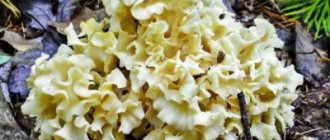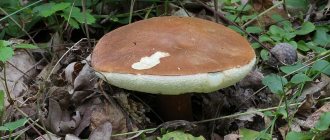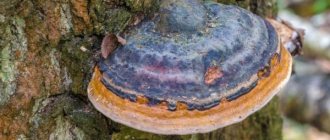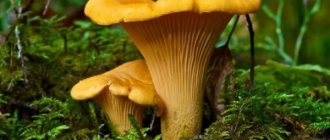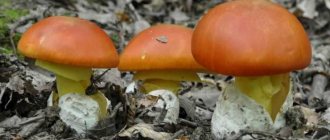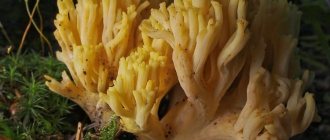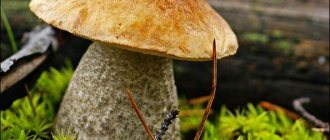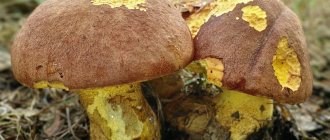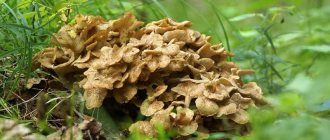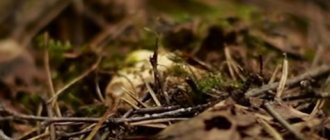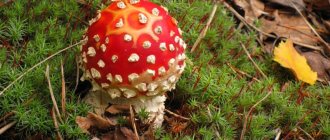Mushrooms
0
1591
Article rating
Kira Stoletova
Sparassis curly is a parasitic mushroom. Causes processes of rotting and decomposition in wood. It looks somewhat similar to cauliflower, so it has many other names associated with this plant: hare, mushroom or hog cabbage.
Characteristics of the mushroom Sparassis curly
Treatment
- The pulp of the mushrooms is very tender, and the amazing taste will not leave anyone indifferent. It is due to its taste that curly sparassis has become famous in the culinary world.
- As mentioned earlier, only young mushrooms are suitable for food. Before cooking, be sure to wash the fruit body from the soil. This task is not easy for them.
In addition to excellent taste, the specimen under discussion has many useful qualities. This mushroom is successfully used in folk medicine. Thanks to special compounds, it is possible to suppress the development of tumors in the body.
Cooking methods
In cooking, curly mushroom can be consumed raw after proper cleaning and washing. It can become the basis for salads and soups. Ideal for casseroles with cheeses, nuts and seafood. These mushrooms make a delicious filling for pies and dumplings.
Primary processing
The fruiting body is placed in ice water for several minutes to get rid of dust and dirt. This cannot be achieved in any other way, even if the inflorescence is disassembled into sections. After cleaning the remaining dust particles, the fruiting bodies are washed under running water.
Cooking
To cook curly mushroom in a pan, it is initially soaked in ice water for 25 minutes so that it can be easily peeled. After a specified time, the mushroom is cleaned of dust and dirt, and then rinsed again with running water.
Next, it is important to divide it into smaller pieces, put it in a vessel, fill it completely with running water, add salt to taste and let it cook.
When the first bubbles begin to appear in the pan, reduce the heat to minimum, remove the resulting foam, and boil the mushroom pieces for another half hour. After this, the contents are placed on a sieve with holes to ensure complete drainage of the liquid.
Pickling
Curly mushroom can be used for any cooking processing, except for pickling and pickling. It reveals its unique flavor characteristics best when fried or when preparing liquid dishes.
Frying
To fry the mushroom inflorescences, the frying pan is heated to maximum, the sunflower oil is heated, and the pieces are constantly stirred and fried. At the same time, it is possible to preserve the taste characteristics, all the liquid is evaporated, and the contents of the frying pan are reduced by half.
Drying
It is carried out according to the same scheme as for other mushrooms, but with a number of features. Initially, the inflorescence blades are separated from the fruit stem, then they are cut and only after a few hours they are laid out on a thin metal sheet with curved edges. Drying in the oven will take up to five hours with a thermometer reading up to 70 degrees.
If powder is produced after drying, the process is carried out in two stages. Initially, the inflorescences are completely cleaned, stripped in running water. After this, the liquid is allowed to drain and dried for several hours at a temperature of 40 degrees.
Soup recipe
A large onion is fried in butter, 5-10 grams of flour are added to the frying pan and everything is stirred vigorously. After the formation of massive lumps, add water to the frying pan until a puree-like mass is achieved and pour in the mushroom powder. At the same time, you need to cook vegetable broth; you can finely chop potatoes and carrots into it, and add pasta. After cooking the vegetables, add the dressing prepared in a frying pan to the broth. It can be used separately, adding to pasta or pouring over any porridge.
Video: curly sparassis (Sparassis crispa)
The curly curly sparassis mushroom has a huge number of names among the people - this is mushroom cabbage, and ram mushroom, and hare cabbage, and so on. This mushroom is quite edible. It consists of a stalk that goes deep into the ground and a large number of twisting branches that form a round body similar to a cabbage. That's why they called him that. The stem of this mushroom is short, quite thick, and can reach five centimeters in diameter. It can reach from twelve to fifteen centimeters in length, but due to the abundance of these very curly branches it is not visible. A young mushroom has a stalk of a light yellow hue; with age it darkens, and by old age it generally becomes black.
The height of this mushroom reaches twenty centimeters, no higher, and in diameter it can grow up to 65 centimeters, the weight of such mushrooms ranges from seven to ten kilograms. Sparassis lobes usually grow up to three centimeters wide and one centimeter thick. The curls of a young mushroom are white; with age they begin to darken starting from the edge. The pulp of the young mushroom is fragile, with a specific aroma. With age, the smell does not change, and the flesh becomes more elastic. You can stumble upon this mushroom from August to October.
How much does mushroom cabbage (sparassis curly) cost (average price per 1 kg)?
This unusual-looking mushroom can easily be mistaken for a head of cauliflower, but this forest dweller is still a type of mushroom that is actively used as food. Mushroom cabbage, which also goes by a number of other names (hog cabbage, hare cabbage, mushroom happiness, curly drigel, as well as curly or curly sparassis) is listed in the Red Book of Russia as a rare species.
By the way, it is noteworthy that there is also a non-scientific name for the mushroom - ram mushroom, which is mainly used in translations of books by foreign authors. The fact is that in Russian mycological literature this name refers to a slightly different type of fungus, which belongs to the Tinder fungus family - Grifola frondosa.
On the territory of Russia, mushroom cabbage (Sparassis curly) can be found in the Altai, Krasnodar, Krasnoyarsk, Primorsky and Khabarovsk territories, as well as the Novosibirsk, Chelyabinsk, Moscow and Sakhalin regions. In addition, this mushroom is often found in the North Caucasus and the Republic of Karelia. Outside the Russian Federation, mushroom cabbage (Sparassis curly) is known in the Baltic states, Ukraine, Belarus, Georgia, Western European, Asian countries and North America.
Mushroom cabbage (Sparassis curly) is distinguished by a fruiting body that is bush-shaped, round, spherical or irregularly spherical in shape. This is a rather large mushroom, the weight of which sometimes reaches 6-10 kilograms. Externally, the fruiting body of mushroom cabbage (Sparassis curly) actually resembles the head of cauliflower. At the same time, young mushrooms are characterized by a whitish color, which a little later becomes yellowish, and in a mature state it turns into ocher or brownish shades. The edges of the mushroom blades begin to darken first.
The dense pulp of mushroom cabbage (Sparassis curly) is white in color and quite brittle when young. Over time, and when it dries, it becomes hard, waxy-horn-like consistency, but still has a strong specific odor, which is completely different from a mushroom one. In terms of taste, mushroom cabbage (sparassis curly) is more like a nut.
This edible mushroom is mainly suitable for making soups, but can also be used for frying and drying. However, this mushroom is suitable for food only at a young age, since the brownish fruiting body becomes very hard. Mushroom cabbage (sparassis curly) is considered an excellent filling for dumplings; it is often baked with shrimp, spices and almonds and cheese. In dry form, the mushrooms are crushed into powder, after which a tonic drink is prepared based on it.
Brief description of edible mushroom
You rarely see it in nature. It can be seen in tree bark once every few years, so it was listed in the Red Book of most domestic regions and European countries. The unique hare cabbage mushroom grows mainly in the Northern Hemisphere, and especially in coniferous forests.
The diameter of the cap reaches 20-50 mm. It can be polished or rough. Its shade is white, milky, grayish or waxy. The fruiting body of the mushroom is a bush. The shape is round, like a ball. Height starts from 50–200 mm. The width reaches 300 mm, in rare cases – 60 mm. The weight is significant - up to ten kilograms.
The curly mushroom is characterized by many lobes or “curls” that extend from the main shoot. There are hymenia on both sides of each shoot.
The shape of the blades is flat, wide, up to 8 mm thick. The boundaries are often unclear.
Regarding the hymenophore - it is smooth or rough, waxy, white, cream or with gray spots. The young mushroom is quite light, almost snow-white, but over the years it begins to darken. Initially, the upper ball of the blade becomes dark, then its other part also changes.
On both sides the leaf is covered with a hymenium - a ball that contains powdered spores.
Its color matches the shade of the mushroom - at first it is almost white, then with yellow spots, but over the years it acquires a dark, brown color.
The pulp is snow-white, with a strong structure. In a young plant, it quickly crumbles and breaks (after a month and when it dries, it becomes hard and waxy), with a sharp, distinct smell, which absolutely no one associates with a mushroom one, but rather with a nutty taste.
Tuberous, minimal in size, dense, underdeveloped, more like a root. The leg is placed in the center, deeply immersed in the ground, so despite its length (130 mm), it is completely invisible from the outside. The color of the shoot of a young plant is white or yellow, later it becomes brown or black.
A little history
This species was first described (received a binomial name) by the scientist Elias Magnus Fries in 1821.
Medicinal properties of hare cabbage
Sparassis curly contains bioactive components with antitumor (immunomodulatory) and antimicrobial activity.
Polysaccharides isolated from the mushroom (1,3-P-glucans) suppress the growth of sarcoma-180, leukemic cancer cells and liver cancer cells, and also enhance the hematopoietic response and increase natural antitumor protection. P-glucans increase the level of synthesis of interferon-γ (IFN-γ) and interleukin-12, increase the production of macrophages and tumor necrosis factor a (TNF-a).
In addition to P-glucans, other free low-molecular compounds were also found in the hot aqueous extract. Due to the medicinal properties of hare cabbage, this mushroom is used in the manufacture of drugs that suppress tumor activity and increase the synthesis of interferon.
Three antifungal agents, including the previously known sparassol, were isolated from a deep mycelial culture of S. crispa. Two other substances, ScI and ScII, have significantly higher antifungal activity, including against Cladosporium cucumerinum, which is resistant to sparassol. S. crispa has been shown to be one of the few fungal species that suppresses the HIV virus.
Dichloromethane extract of fruiting bodies (2002 study) showed antimicrobial activity against Bacillus subtilis and Escherichia coli. Repeated studies in 2007 identified new bioactive antibacterial components previously found in the medicinal polypore Antrodia camphorata cultivated in Asia. The isolated substances suppress Staphylococcus aureus and at the same time stop the growth of melanoma (skin cancer).
The mushroom is widely cultivated in Asian countries to obtain medicines and dietary supplements.
How to stew cabbage with mushrooms in a slow cooker
Cabbage with mushrooms in a slow cooker is very easy to prepare. You will need:
- 300 g champignons;
- 0.5 kg of white cabbage;
- 1 onion;
- 2 carrots;
- garlic;
- sunflower oil;
- water;
- salt.
Algorithm of actions:
- Mushrooms are cut and fried in oil in the “baking” mode, which is set for 15 minutes.
- Add chopped carrots, garlic and onions to them, leave under the closed lid for another 5 minutes.
- The cabbage is finely chopped and placed with the vegetables.
- Pour in a glass of hot water, salt, mix everything and cook for another quarter of an hour.
- The cooking time in the “baking” mode is 40 minutes. After they expire, turn on the “quenching” mode for an hour.
- The dish is sprinkled with herbs and served.
Mushroom happiness: using mushrooms
In traditional Chinese medicine, the fungus mushroom is used to normalize blood pressure, regulate blood sugar levels, and to prevent strokes and tumor diseases.
Edible at a young age, the mushroom has good taste and does not require pre-boiling. Suitable for all types of culinary processing, can be dried, not suitable for pickling or pickling. Since mushroom cabbage contains substances that prevent the development of mold fungi, the fruiting body can be stored for a long time at low temperatures (in the refrigerator).
www.5lepestkov.com
How to cook mushroom
It is necessary to cook the mushroom according to a certain algorithm, which is suggested by those who have repeatedly dealt with this type of mushroom.
- Immerse in cold water for ¼ hour. This will make it easier to clean off “forest debris” - stuck pine needles, grass.
- Rinse the fruit bodies with cold water and chop with a knife and fingers.
- Pour over the chopped pieces so that the liquid covers their surface, and add salt.
- Cook for 20 minutes. After boiling and foam appears, reduce the heat and remove the noise.
- Let the boiled mass drain in a colander.
Important. Sparassis curly is indigestible. Otherwise, it will fall apart and lose its extraordinary taste properties. For the same reason, you should not add spices. To give a richer taste, boil in milk.
Dryagel curly, also known as curly sprassis, is suitable for any type of culinary processing with the exception of salting and pickling. Those who eat this mushroom quite often confidently say that it works best when frying, stewing with sour cream and making soups. In addition, it is recommended to bake it with cheese, meat, and seafood. This will be an excellent filling for savory pastries. Dried and powdered mushrooms are also perfect for sauces and gravy.
But, it is important not to forget that since this is a tree mushroom, its fruiting bodies will be edible only if they are light in color (youth). Older specimens already acquire a bitter taste and become woody. For your information. No cases of poisoning with Sparassis curly have been reported.
Beneficial features
Mushroom cabbage has a lot of useful properties, and therefore is actively used in folk medicine, but since curly sparassis is an endangered species, its collection and preparation in natural habitats is prohibited. However, mushroom cabbage is still not a scarce product, since the technology for artificially growing this mushroom has been well developed.
Varieties of curly sparassis differ in ripening time and color - artificially grown mushroom cabbage can be of different shades: from white to cream. The mushroom grows well on specially treated wood sawdust and is very productive.
Sparassis curly contains a lot of polysaccharides, which are known for their ability to resist the formation of tumors,
and immunomodulatory substances. In addition, mushroom cabbage is widely used in dietetics; due to its low calorie content, it successfully helps in weight loss, and is even included in some specially designed diets.
A natural antibiotic resistant to the development of staphylococcus and various components with antimicrobial activity were found in mushroom cabbage.
Cabbage with mushrooms and potatoes
For the next variation on a given theme, it is better to take wild mushrooms, but store-bought champignons will also work. To prepare, you will need a set of products, which, of course, every housewife will find in the house.
- 200 g mushrooms;
- 2 tbsp. spoons of tomato paste;
- 2 carrots;
- 200 g potatoes;
- 2 pcs. onions;
- 1 head of white cabbage;
- vegetable oil;
- salt, pepper, spices.
What they do:
- Finely chop the onion and grate the carrots.
- Pour oil into a hot frying pan and lay out the prepared root vegetables. Reduce the heat when they are browned.
- Mushrooms are washed, peeled, and chopped into equal parts. Pour them into a frying pan and pour tomato paste over them. Everyone simmers for a minute.
- The cabbage is cut into thin strips and added to the other ingredients. The mixture is simmered for a quarter of an hour.
- Boil the potatoes for 15 minutes, drain the water, cut them into cubes or plates, and place them in a cauldron.
- Add bay leaf and vegetable dressing and simmer over low heat under the lid for 10 minutes.
- The dish is cooled slightly and served with a leaf of fresh parsley.
Use in cooking
Young mushrooms are used in cooking; they are very tasty and the texture most closely resembles morels. The smell of mushroom cabbage is quite specific, and its taste is more like a nut.
It is suitable for making salads even in its raw form; it is used to make soups and baked with cheese, nuts and seafood. Sparassis curly is also often pickled, and in this form it is quite often found on sale. Mushrooms make an excellent filling for pies and dumplings, and dried mushrooms, ground into powder, are added to various sauces, gravies and tonic drinks.
It is better not to use old mushroom cabbage; it is quite tough and has a pronounced bitterness.
Sparassis or mushroom cabbage soup, recipe
People call sparassis curly king mushroom or mushroom cabbage for its nutritional value, benefits, pleasant delicate consistency of the pulp and special nutty taste. You will learn how to cook mushroom cabbage by cooking a delicious soup from the detailed recipe.
- Take a large onion for soup, about 100 g. Cut it into small cubes.
- Fry the onion with vegetable oil. It is better to choose olive oil. You can fry the onions immediately in a non-stick pan with a thick bottom in which the soup will be cooked.
- Divide the washed sparassis into small pieces. Place in a colander and wash again under running water.
- Chop the mushroom into small pieces and add to the onion, which is fried in a pan.
- Add sweet paprika to the onions and mushrooms.
- Boil 300 ml of water.
- When the water boils, do not forget to skim off the foam. Add spices to the soup - a few black peppercorns, a pinch of ground black and red pepper, oregano.
- Prepare a flour dressing for the soup, which will thicken it. Two tbsp. l. Grind flour with vegetable oil.
- Add 1 liter of cold water to the pan with the mushrooms and onions.
- Peel 4 cloves of garlic and grate them.
- When the water in the pan boils, add the prepared flour dressing, a teaspoon of salt and the prepared garlic.
- Serve the finished soup, garnished with a sprig of dill.
An original dish, easy to prepare. It turns out very aromatic, thanks to the bouquet of spices and the special taste of mushroom cabbage.
How to cook?
How to cook mushroom cabbage? In cooking, to prepare various dishes, sparassis curly is boiled, baked and stewed together with other products, fried, dried, pickled and salted (some cooks do not recommend using the last two methods of preparing this product). But all recipes for preparing mushroom cabbage say that you should use only young, light-colored mushrooms. If curly sparassis has a brown tint, it means the flesh will be hard and undercooked.
You can cook mushroom cabbage either in a regular saucepan or in special kitchen appliances (multi-cooker and double boiler). Let's look at each cooking method in more detail.
To cook curly sparassis in a saucepan, you will need a couple of these mushrooms, which should first be soaked in cold water for a quarter of an hour to make them easier to clean. After fifteen minutes, clean the mushroom cabbage from dust and dirt, and then rinse again under running water. Next, the mushrooms need to be divided into smaller pieces, placed in a container, completely filled with water, salt to taste and put on the stove. When the broth begins to bubble in the pan, reduce the heat to low, skim off any foam that appears and boil the pieces of mushroom cabbage for about twenty minutes. After this, the boiled curly sparassis should be placed in a colander to drain the remaining liquid.
How to cook mushroom cabbage in a slow cooker? First, you need to put the peeled and chopped mushrooms in a special steamer, and pour water into the container for the device. Next, place the steamer with mushroom cabbage on top of the multicooker container, close the lid and turn on the “Steam” program, setting the timer for half an hour. At the end of this program, pour the liquid out of the container of the electrical appliance and transfer the pieces of curly sparassis there, adding salt at your discretion. Select the “Extinguishing” program for twenty minutes. By the way, you should not add water to the mushrooms, as they will languish in their own juice. When the mushrooms have stewed a little, switch the “Stewing” program to “Baking”, setting the timer for ten minutes so that the remaining moisture comes out of the mushrooms.
Cooking mushroom cabbage in a double boiler does not take much time and labor.
Pour water into a special tray of a household appliance, place a container on top, placing pieces of washed and peeled curly sparassis there. Close the steamer and set the timer for thirty minutes.
When cooking mushroom cabbage, you should not add various spices to the broth, because this can spoil the specific aroma of the mushrooms and their nutty flavor. You should also adhere to the specified time. If you overcook Sparassis curly, it will fall apart and lose its flavor.
To taste fried mushrooms, you need to peel, wash and disassemble the mushroom cabbage into small inflorescences or simply cut it. Next, throw a little butter into a heated frying pan and, when it melts, lay out the inflorescences of curly sparassis. Fry the mushrooms over medium heat for about twenty minutes, stirring regularly.
Dry mushroom cabbage in the same way as other types of mushrooms. But first you need to divide the curly sparassis into inflorescences, then cut it, and then spread it on a baking sheet covered with parchment paper. Such a mushroom must be dried in an oven with the door ajar at a temperature of no more than seventy degrees for five hours. If the house has a special electric dryer, drying time will take about three hours.
If, after drying, a powder is made from mushroom pieces, it means that the mushroom cabbage inflorescences should first be soaked in water, then dried, then placed on a baking sheet and dried in the oven for about three hours at a temperature of forty degrees. After this, increase the temperature to sixty degrees and dry for no more than four hours.
To make mushroom powder from dried sparassis curly, you need to grind pieces of dried mushroom cabbage in a blender to a powdery state, adding salt to taste and a little cloves and cinnamon. This spice should be stored in a glass container with an airtight seal.
Growing methods
The wild sparassis mushroom cannot be used for personal use due to its rarity. But you can grow it yourself. When growing at home, the technology is the same as when cultivating oyster mushrooms. The only difference is that sawdust must be taken fresh and only from coniferous trees.
Irina Selyutina (Biologist):
Indeed, cultivating curly sparassis on sawdust is similar to growing oyster mushrooms, however, let's highlight the main points in growing sparassis:
- Coniferous wood sawdust (pine, spruce, cedar, fir, larch) should not contain even traces of chemical compounds used to treat wood in the fight against parasites and pathogens.
- Sawdust is mixed with a small amount of bran, hay, gypsum, and combined mineral supplements.
- Pour the prepared mixture with water and boil for 1-2 hours to destroy the competing microflora present in the substrate.
- Cool the mixture completely in the water, then drain it and spread the mixture onto a fine mesh, allowing the water to drain. An indicator of the readiness of the substrate is that the sawdust should be damp to the touch, but should not stick to your hands. This will be the optimal humidity level - 70%.
- Place the prepared substrate in plastic bags: each layer of substrate 5 cm thick is sprinkled with crushed mycelium. The bag is tied tightly.
- When the mycelium germinates and covers the substrate, 2x2 cm holes are cut in the bags for the fruiting bodies to emerge to the surface.
The fruiting bodies are cut with a knife.
This species is best grown in a personal plot using a fallen or felled tree. It is advisable to choose coniferous tree trunks. The wood must be fresh and untidy. Holes are made in it with a drill at a distance of 10-15 cm, filled with mycelium, and the hole is sealed with sawdust. The log must lie with its entire lower surface on the ground so that it is possible to draw moisture from it. The method of growing on a log is considered less troublesome compared to growing it on a block.
The mushroom is widely grown in Japan and Korea. Not only food products are made from it. The substances contained in the plant are widely used in the manufacture of medicines and dietary supplements.
Benefits of mushroom cabbage (sparassis curly) and treatment
The benefits of Sparassis curly are well known in the treatment of malignant oncological diseases, especially melanoma and sarcoma.
.
In gynecology, it is used in the treatment of various hormonal disorders and non-oncological tumors. Mushroom cabbage is one of the components used in the treatment of various types of diabetes, and is used as an antiviral drug for the treatment of viral hepatitis. These mushrooms have proven themselves well for the treatment of obesity, since their use causes persistent weight loss, while at the same time not depriving the body of the minerals and amino acids it needs.
Harm and contraindications to eating mushroom cabbage
Mushrooms have a common negative property: they absorb harmful substances from the external environment. Sparassis curly grows on trees and does not come into contact with the soil, but this does not mean that the fruiting body is harmless with respect to toxins. The mushroom absorbs gases and salts of heavy metals dispersed in the air, so it cannot be collected in the area of highways and in cities.
Contraindications for the use of Sparassis curly:
Food allergy to mushrooms;
Diseases of the gastrointestinal tract in the acute stage;
You should not introduce dishes from Sparassis curly into the diet of pregnant women, children under 3 years of age and the elderly. Representatives of these categories have a slow adaptation to a new product; enzymes that facilitate absorption are not produced in sufficient quantities. Indigestion can cause symptoms of intoxication: nausea, vomiting, headache, abdominal pain and indigestion.
Description
Curly sparassis (Sparassis crispa) belongs to the Sparasaceae family, which unites only 7 species. This edible mushroom, due to its unusual appearance, has several names: mushroom happiness, mushroom cabbage, ram mushroom, hare cabbage, curly friegel, hog cabbage and king mushroom. By the way, the name “ram mushroom” in relation to sparassis is usually used only in foreign reference books. By this name, Russian mycologists mean one of the tinder fungi - curly griffola.
- the fruiting body consists of a large number of fleshy, curly, branched lobes and resembles a lush spherical bush. The dense lobes are smooth or wrinkled and have a dissected or wavy edge. The mushroom sometimes reaches quite large sizes: the diameter of the fruiting body is usually 6-35 cm, but individual specimens grow to a record 60 cm. Its height is about 20 cm, and its weight often exceeds 6-8 kg: it happens that mushrooms weighing up to 14 kg. The color of the fruiting body in young mushrooms is whitish-yellow, and in mature ones it is brown with a hint of rust;
- the stem is root-shaped, attached to the middle of the fruiting body, thick (up to 5 cm in diameter), goes deep into the ground and is therefore little noticeable. Its length is about 13 cm. The color is yellowish-white, sometimes darkening with age to black;
- the flesh is dense and fleshy, fragile in young specimens, similar to wax, in adults it is hardened and hard. It has a nutty taste and emits a strange smell that is not at all similar to the aroma of mushrooms;
- the spore-bearing layer is located on one side of each blade of the fruiting body. It has a grayish or white-cream tint, slightly rough to the touch or, conversely, smooth;
- spores are ellipsoid, from white to light yellow.
Description of the mushroom
Sparassis curly lives on coniferous trees. The population has recently declined significantly due to the cutting down of old-growth coniferous forests. In addition, people have contributed their efforts to the disappearance of this type of fungus. Now it is listed in the Red Book of Russia, Belarus, and Ukraine.
The mushroom is rarely found in our forests, especially large specimens. It appears in the second half of the summer season and can be seen until mid-autumn. The above-ground body can range in diameter from 10 cm to 60 cm. Sometimes fruiting bodies weighing 6-10 kg are found.
According to the species description, curly sparassis has a rounded, elongated shape, it looks like a branched coral or a branched tree. Consists of flat branch-plates. They have a wavy, jagged edge. Young mushrooms are white and cream-colored. They become darker with age.
Irina Selyutina (Biologist):
Young sparassis is really whitish, but with age it is not just yellowish, but acquires an ocher color or turns brown. Moreover, the darkening begins from the edges of the blades of the fruiting body. The pulp is white and dense, has a smell that is not like a mushroom and a taste that is reminiscent of a nut. Young mushrooms have brittle flesh, but over time it becomes woody.
The central leg reaches a length of 13 cm, but almost all of it is hidden underground. This is due to the fact that curly sparassis is a parasitic species that settles on the roots or at the base of the trunk of a coniferous tree, causing the development of red-brown destructive (destructive) rot of the roots and base of the trunk. Sometimes it can settle on fresh stumps.
While the mushroom is young, its wide, up to 5 cm stalk, from which all the blades grow, has a shade variation ranging from white to pale yellow. But as it grows and, accordingly, ages, it darkens and becomes brown or black.
For your information. If in a deciduous forest on an oak tree you come across a mushroom similar to curly sparassis, you are very lucky, because you were able to meet the closest relative of this species - sparassis lamellar.
Sparassis curly settles on coniferous trees
The consistency of the pulp in the plates also reveals the age of the specimen. In young ones it is soft, tender, the taste is nutty and pleasant. Over time it becomes tougher and can no longer be used for food.
Properties of the mushroom
Sparassis curly contains a large amount of beta-glucan polysaccharide, more than 40% of dry weight. This substance has strong immunomodulatory properties and is widely used in pharmacology all over the world. It is a strong antioxidant, counteracts the development of tumor, inflammatory and allergic processes.
Sparassis curly contains sparassol, a compound that prevents the development of mold fungi and protects against pests and various diseases. It also benefits people, as it has antimicrobial and antimycotic activity.
The components of Sparassis curly have the following medicinal properties:
- antitumor;
- antioxidant;
- immunomodulatory;
- antibacterial;
- antifungal.
The mushroom helps allergy sufferers, hypertensive patients and people who have suffered post-stroke conditions, as well as those suffering from diabetes.
Traditional medicine is known for the effectiveness of Sparassis curly in the fight against malignant tumors, especially melanoma and sarcoma. It is also used in the treatment of hormonal disorders and obesity.
By the way. In the countries of South-East Asia, Sprassis has long been widely used in pharmacology.
Distribution and fruiting season
This type of mushroom grows in the Northern Hemisphere and is found in mature coniferous or coniferous-deciduous forests of the Krasnodar, Khabarovsk, Krasnoyarsk territories, Altai, Primorye, Karelia, as well as in the Moscow, Sakhalin, Chelyabinsk regions and the Caucasus. It also grows in Georgia, the Baltic states, Asia, some European countries and North America. The fruiting period is August-September.
Sparassis can cause the development of red-brown rot, which often causes plant death.
Special properties and medical applications
Dancing mushroom is very rich in vitamins B and D. It contains a lot of fiber, polysaccharides and amino acids. Maitake contains large amounts of important minerals such as calcium, potassium and magnesium. The main feature is that the entire “arsenal” of useful substances is not lost during cooking.
In medicine, its unique properties have occupied a special place for many years, both in folk and professional medicine. For greater clarity, we will highlight separate groups of diseases for the treatment of which the healing properties of maitake are used:
- Diseases associated with disruption of the proper functioning of the vascular system. Cardiologists recommend medications made from maitake extract for problems with high blood pressure. Also, its use in food will serve as a good prevention against such diseases;
- Ram is an excellent disinfectant. Various antibacterial ointments and preparations are produced on its basis;
- Experts advise taking maitake-based medications to women who are having a hard time with menopause. Unique properties help normalize hormonal levels, reduce sweating and pain;
- Nutritionists also advise taking it as food. They claim that by using maitake as a supplement, you can lose up to 10-15 kilograms of weight in two months;
- In recent years, scientists have conducted a number of studies on the healing properties of maitake, and have proven that the healing qualities help the body better fight hepatitis and cirrhosis;
- The high concentration of natural polysaccharides makes the mushroom very useful for diabetics. Maitake can significantly lower blood sugar levels;
- Experts also began to widely study the effects of maitake components on cancer cells. Experiments have shown that its beneficial substances prevent the formation of malignant cells in the body, and protect it from the appearance of tumors in general.
- The use of maitake in the treatment of HIV diseases also continues. Scientists have noticed a unique effect of its active components on the activity of T-lymphocytes in the human body.
Maitake mushroom is also used to increase the overall tone of the body. Used to calm the nervous system.
The representative of curly hair is also extremely popular among cosmetologists. They note the rejuvenating effect of ointments based on it. Healing components very effectively restore damaged and old skin cells.
Similar species and how to distinguish them from them
The peculiar appearance and habitat of growth practically excludes the possibility of confusing Curly Sparassis with any other species. Externally, it has a strong resemblance to sparassis laminosa. However, it is quite easy to distinguish them from each other - the lamellar one has more rigid blades with a solid edge, is yellow in color, and grows mainly on oak. This is also an edible and tasty mushroom that is under protection, but it is even less common than the hero of our article.
With mushrooms and meat
Need to quickly prepare a hearty dinner for a large family? Nothing could be simpler. To do this you need to take:
- 1 kg of white cabbage;
- 500 g pork, beef or chicken;
- 2 onions;
- carrot;
- 300 g fresh mushrooms;
- fresh tomatoes or tomato paste;
- garlic;
- spices and salt.
Preparation:
- The meat (you can take ribs) is cut into small pieces and fried in a hot frying pan with butter until golden brown.
- Finely grate the carrots, chop the onion, and add everything to the meat.
- The mushrooms are washed, peeled and cut, and added to the rest of the ingredients. Everything is fried over medium heat.
- The cabbage is chopped, added to vegetables and meat, and continued to be fried over low heat.
- When the vegetables are browned, add tomato juice or crushed tomatoes and season with spices.
- Add bay leaf and crushed garlic, keep covered for a few more minutes.
Primary processing and preparation
Very pleasant taste and delicate pulp - these are the qualities that curly sparassis has become famous in cooking. It is usually fried, dried or made into soups. Only young fruiting bodies are suitable for cooking, as they are still quite soft. Mature mushrooms, the flesh of which has darkened, become tough. Before use, sparassis must be thoroughly washed off the ground. Let us note that he is reluctant to part with the dirt.
This mushroom is not only tasty, but also healthy: it is often used in folk medicine. It contains substances that have a suppressive effect on cancer cells. Also, the pulp of the mushroom has an immunomodulatory and bactericidal effect. Unfortunately, this species is on the verge of extinction due to irrational exploitation of the forest fund. Therefore, if you encounter this type of sparassis in the wilderness, it is better to just take a photo of it as a souvenir, and do not collect this rare mushroom.
mirgribnika.ru
Mushroom cabbage
, or
Curly Sparassis
(Sparassis crispa) is a type of mushroom that looks like a head of cauliflower.
It grows in Europe and Asia, and can even be found in North America in August - September.
Outwardly similar to cauliflower, it can be light in color, but over time it darkens and becomes yellowish, even brownish. Weight can reach up to 10 kg, and up to half a meter or more in diameter.
This species is not often found, therefore it is in the Red Book.
Mushroom cabbage tastes good, is nutritious and healthy. Calorie content - 30 kcal, contains all nutrients: proteins - 3.7 g, fats - 1.7 g, carbohydrates - 1.1 g.
It has valuable properties, but it cannot always be widely used in folk medicine, as it is in the Red Book.
It is known, thanks to its polysaccharides, for its ability to prevent the formation of tumors and has immunomodulating properties.
It has antibacterial properties and antimicrobial activity against staphylococci.
Can be used in dietetics: due to its low calorie content, it is included in various diets and can reduce weight.
From mushroom cabbage
you can prepare various dishes.
For this purpose they are grown artificially. Sparassis grows well in artificial conditions on sawdust and has color variations from white to cream.
Young mushrooms look like morels.
You can make salads from mushroom cabbage, including adding it raw, as well as soups and other dishes. You can add or cook some dough with sparassis: pies, dumplings.
After drying and grinding into flour, the mushroom can be used in sauces, tonic drinks, and gravy.
Beneficial features
allow use in the treatment of:
In gynecology it can be used as a hormonal agent.
It should not be used in diet or treatment by persons with individual intolerance, food allergies, or diseases of the gastrointestinal tract.
www.bolshoyvopros.ru
Other names:
- Sparassis curly
"Mushroom Happiness"
Mushroom cabbage
Borovaya cabbage
Hare cabbage
Dryagel curly
Sparassis curly, appearance:
Where does Sparassis curly grow:
Grows from August to October
in coniferous forests, most often near pine roots. In the Russian Federation it can be found in Altai, Krasnoyarsk and Primorsky territories, as well as in Krasnodar and Khabarovsk.
Areas of distribution:
Novosibirsk, Moscow, Sakhalin - Kunashir Island, Chelyabinsk, in the Republic of Karelia and the North Caucasus. Outside Russia, it was found in the Baltic states, Georgia, Belarus, Ukraine, in the countries of Asia, Western Europe, and in the east of North America.
Sparassis curly: use
A very tasty edible mushroom. It has a strong specific smell, which has no similarity with mushroom, and is valued by lovers for its nutty taste. But the older the mushroom, the more inedible it is; overripe specimens become bitter and unsuitable for food. It is usually used dried and fried, suitable for making soups, and is known in folk medicine.
Spasassis curly: similar species
Sparassis lamellar is very similar to curly sparassis
-
Sparassis laminosa
, which has yellow flocculent branches that are rougher, flatter and smoother. It grows in late summer and also in autumn in deciduous forests, most often near the roots of oak trees. Just as tasty as curly sparassis, but much less common.
The ram mushroom
Grifola frondosa
and
the branched tinder fungus Grifola umballata are also
similar to it . These mushrooms are found at the very base of the trunk or stump of a deciduous tree (oak, elm, etc.)
Sparassis curly, curly - PHOTO:
A mushroom with the unusual name mushroom cabbage, hare cabbage, mushroom happiness, or curly sparassis (Sparassis crispa) has a lot of useful substances, but is a rare species, therefore it is protected by law in many countries of the world.
Composition and caloric content of Sparassis curly
Only young mushrooms are used for food, since the blades of a mature one become hard and immediately sow spores.
Caloric content of curly parassis is 31 kcal per 100 g, of which:
- Proteins—1.94 g;
- Fats—0.19 g;
- Carbohydrates - 6.97 g;
- Dietary fiber - 2.7 g;
- Ash - 0.53 g;
- Water - 87.67 g.
Vitamins contained in Parassis curly per 100 g:
- Vitamin B1, thiamine - 0.146 mg;
- Vitamin B2, riboflavin - 0.242 mg;
- Vitamin B4, choline - 51.1 mg;
- Vitamin B5, pantothenic acid - 0.27 mg;
- Vitamin B6, pyridoxine - 0.056 mg;
- Vitamin B9, folate - 21 mcg;
- Vitamin D, calciferol - 28.1 mcg;
- Vitamin D2, ergocalciferol - 28.1 mcg;
- Vitamin E, alpha tocopherol, TE - 0.01 mg;
- Vitamin RR, NE - 6.585 mg.
Macroelements per 100 g:
- Potassium, K - 204 mg;
- Calcium, Ca - 1 mg;
- Magnesium, Mg - 10 mg;
- Sodium, Na - 1 mg;
- Phosphorus, Ph - 74 mg.
Microelements per 100 g:
- Iron, Fe - 0.3 mg;
- Manganese, Mn - 0.059 mg;
- Copper, Cu - 252 μg;
- Selenium, Se - 2.2 μg;
- Zinc, Zn - 0.75 mg.
Composition of digestible carbohydrates per 100 g:
- Mono- and disaccharides (sugars) - 2.07 g;
- Glucose (dextrose) - 1.74 g;
- Lactose - 0.33 g.
The benefits of Parassis curly are provided by essential amino acids, per 100 g:
- Arginine - 0.1 g;
- Valine - 0.1 g;
- Leucine - 0.08 g;
- Lysine - 0.09 g;
- Threonine - 0.095 g.
Essential amino acids per 100 g:
- Alanine - 0.124 g;
- Aspartic acid - 0.205 g;
- Glycine - 0.09 g;
- Glutamic acid - 0.264 g;
- Serine - 0.1 g;
- Tyrosine - 0.07 g.
Parassis curly contains the sterol campesterol - 2 mg per 100 g.
Mushroom cabbage contains omega-6 fatty acids in the amount of 0.09 g per 100 g, as well as oleic, palmitic, linoleic acid - 0.03 g.
Nutrients are necessary for the functioning of the human body, they participate in the metabolic process and in redox reactions:
- Vitamin B2
. Required to support visual function, is responsible for the condition of mucous membranes, supports twilight and light vision, accelerates adaptation to changes in illumination.
General information and description
In appearance, the mushroom resembles a head of cauliflower, which is why it has this name. In England they are called "brain mushrooms" or "ruffle mushrooms". All names quite accurately convey the characteristics of the mushroom, which, instead of the usual cap, has a whole bunch of twisting, branched branches-blades growing from the central stump.
The size of the mushroom exceeds the size of many edible mushrooms - its height is from 5 to 35 cm, and its diameter is from 5 to 60 cm. The color is cream or pale yellow; with age, the branch-blades acquire an ocher-brown, dark color.
The pulp of a young mushroom is white, with a resinous aroma and a nutty taste, but in mature specimens it becomes tasteless, hard and bitter.
The leg matches the mushroom - thick, up to 15 cm long, light yellow in color, sometimes with brown spots. With age, the color changes to black.
The habitat of hare cabbage is quite wide, but the mushroom remains a rare occurrence in the forests of Europe, Eurasia and North America.
Most often, the mushroom can be seen at the base of the trunk or on a fresh stump. Moreover, it grows on them for several years, and bears fruit from mid-summer to late autumn.
Mushroom happiness in the photo
Growing at home and in the country
If there is a large plot of land, for example, in a garden or country house, the mushroom can be grown in a single piece of wood. This technique is good because it eliminates the need for frequent substrate replacement. On wood without flaws, sparassis will develop for several years, rather than a couple of seasons.
To grow, you need to choose coniferous wood trunks. If desired, it is possible to use both a massive log tens of meters long and minimal chips of 5–10 cm.
You need to pay attention to the tree. It must be fresh; this not only prevents the spread of various fungi or microorganisms, but also significantly moisturizes the plant.
In addition, boletus cabbage, in principle, prefers fresh feeding.
Holes are made in the trunk with a drill in increments of 100-150 mm, then they are treated with special antifungal substances and filled with sawdust. The wood is then placed in a part of the garden where there is maximum shade or in a greenhouse so that its entire length touches the ground and there are no gaps anywhere. This prevents the material from drying out: it will begin to absorb droplets of moisture directly from the soil.
Medicinal properties
The hare cabbage mushroom contains many substances that are beneficial to humans; it is an edible mushroom; moreover, it is also used in medicine, producing medicines from it. For these purposes, people have to grow rare mushrooms specially; specialists from the USA and Japan are especially successful in this matter. It was they who developed and patented the technology for growing the mushroom. Under artificial conditions, the mushroom is grown on a sterilized substrate of sawdust and wheat bran.
Sparassis curly contains biologically active substances that have anticancer and antimicrobial effects. The polysaccharides contained in the mushroom stop the growth of sarcoma, kill liver cancer cells, leukemia cells, and stop melanoma. In addition, they improve the blood formula, activate its movement, and produce antibodies that protect the body from cancer.
In addition to polysaccharides, mushroom happiness also contains other compounds that determine its medicinal properties. It is an antifungal agent and sparassol, ScI and ScII substances that can suppress the human immunodeficiency virus.
The antibiotic contained in the fungus inhibits the development of Staphylococcus aureus.
Traditional Chinese medicine uses it to lower blood sugar levels, treat hypertension, and prevent cancer, heart attacks and strokes.
Preparations made on the basis of sparassis are also used in gynecology for the treatment of benign and malignant tumors and hormonal disorders.
The mushroom is used to treat obesity, it promotes weight loss, and at the same time supplies the body with useful minerals and amino acids.
Mushroom cabbage
Evaluation of taste qualities, medicinal properties, benefits and possible harm
Curly mushroom belongs to the edible class; it can become the basis of soup, mashed potatoes or pie. Hare cabbage can be dried, fried, ground into flour and sprinkled on dishes. Only young inflorescences and stems of mushrooms are considered edible.
With age, they become as hard as possible, acquire a brown color and a distinct bitter taste. But curly mushrooms stand out for their taste characteristics; their texture is similar to morels. The smell is special, reminiscent of almonds.
Treatment
Traditional medicine has long been using curly mushroom to treat many diseases, including even oncology.
This is an effective remedy against tumors, it boosts immunity, kills germs and fungi.
The benefits of hare cabbage have been proven in the treatment of even hepatitis of viral etiology. In the field of gynecology, curly mushroom is useful for protection against hormonal ailments. This type is also used in the treatment of diabetes. It actively helps reduce sugar thanks to proteins and numerous minerals. It can be boiled, fried, dried, and it is always delicious.
Mushroom in cooking
Only young specimens of hare cabbage are eaten while they are still soft, tender and light in color. No pre-soaking or boiling is required here; the mushroom is already quite tasty. Overgrown, darkened mushrooms are not used in cooking.
Mushroom cabbage is suitable for frying and drying; these mushrooms cannot be salted or pickled. The substances contained in hare cabbage prevent the development of mold, so the mushroom can be stored for a long time in the refrigerator at above-zero temperatures, or frozen.
Recipe for stewed sauerkraut with mushrooms
Heat-treated sauerkraut has a pleasant sweet and sour taste. To cook it with mushrooms, you need to take:
- 300 g white cabbage;
- 300 g sauerkraut;
- 250 g mushrooms;
- 1 onion;
- 1 carrot;
- 1 tbsp. l. tomato paste;
- vegetable oil;
- spices;
- greenery for decoration.
Preparation:
- The onion is chopped into cubes, the carrots are cut into half rings. The ingredients are fried in oil until golden brown.
- Add chopped mushrooms and fry them until the moisture evaporates.
- The cabbage head is chopped and the straws are added to the fried mushrooms. Everything is fried, stirring, for a quarter of an hour.
- Now the sauerkraut is transferred to the vegetables and simmered for 20 minutes over medium heat. If there is little liquid, periodically add broth or water.
- Then add tomato paste, salt and pepper, and simmer for several minutes. Spicy lovers can add chili pepper.
- Before serving, the dish is decorated with herbs.
Sparassis curly - description of where it grows, the toxicity of the mushroom
Sparassis curly is understood in the literal sense of the word as a curly beige mushroom, which is classified as a member of the Sparass family. There are no more than 7 varieties in this family, which is remarkable. The mushroom is an edible and very tasty variety, but it is listed in the Red Book of our country as an endangered type. Due to deforestation and human gathering, the number of specimens presented is decreasing. Today we will study everything connected with them.
Let us repeat once again that this variety is classified as edible.
The mushroom attracts attention, first of all, because it is famous for its external characteristics. In common people it is called by different names, including mushroom cabbage, lamb mushroom, mushroom happiness, as well as hare cabbage and king mushroom
Moreover, the name “lamb” is used only in foreign reference materials; our compatriots practically do not express it this way. Russian experts by lamb mean a completely different mushroom - curly griffola. Now consider the description of the presented intricate specimen. The fruiting body consists of multiple curly leaves that branch and look like a shrub. The mushroom is quite large; its wrinkled lobes with wavy edges cannot go unnoticed. Considering the diameter, we can say that some fruiting bodies grow up to 20-60 cm. Of course, this is rare; on average, mushrooms with a diameter of 7-30 cm are found. The height of the bush is about 20 cm, and its weight exceeds 6-8 kg . Some mushroom pickers came across specimens weighing 10-14 kg. The fruit bodies are beige, yellow-white in color. Mature specimens have a dark, brownish color with reddish splashes. The base is poorly visible, it is root-like, attached to the center of the body. The thickness of the leg is about 5 cm, for the most part it is dug into the ground, so it is not visible. It grows up to 13 cm in length, is colored white-yellow, and can darken and turn black when overripe. The soft part of the peculiar wavy blades is fragile, easily crumbles and breaks. In mature fruiting bodies it is tough and hard. It tastes nutty and smells strange. The smell has nothing to do with mushroom aroma. Reproduction is carried out by elliptical-shaped spores; they are light yellow or white in color. The layer, otherwise called spore-bearing, prefers to be located on each blade. Moreover, it occupies only one side, without completely wrapping around. In hue, this layer is pigmented creamy white or gray. Feels a little rough, maybe too smooth.
